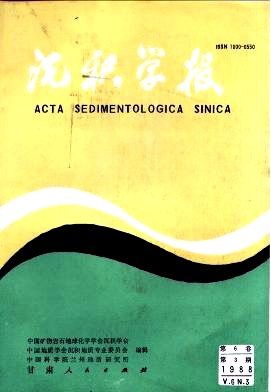PROBE INTO THE RELATION WHICH FORAMINIFERA AND ASSOCIATED BIONOMY WERE TO MICROGACIES OF CARBONATE DEPOSITS AND GENERATION OF OIL-GAS
- Received Date: 1986-07-14
- Publish Date: 1988-09-10
Abstract: Through studying foraminifera and associated bionomics in the upper Carboniferous-Lower Permian sedimentary section of YaoLin, ZheJiang province, China, the paper divided the benthonic foraminiferas from carbonate platform into three types of assemblages. Type 1 ( R ) is the assemblages of the foraminifera from the restricted sea platform, which are characteristic of minor bodies and walls with fibrous and micritzed texture, such as Nodosaria, Glomospira, Geinitzina, Ammodiscus, and Eolasiodiscus. Type 2 ( O ) is the assemblage of the foraminifera from the open sea platform, which are characteristic of large bodies and shells with two-layer texture, Such as Cribrogenerina, Climacammina, Pachyphloin, Padangin, and Endothyra. TypeS ( B ) is the assemblage of the foraminifera from the basin, which are characteristic of minor bodies and shells with the fine sparry texture, associated with minor and thin-shell Ostrcada, and mixed with a lot of afloat Rodiolarians. The genus and species of the foraminiferas are similar to the type 1. According to the differences of rock textures, mineral compositions, foram-iniferal features and sedimentary strcutures, these have been divided into R1 R2 Ra O1O2 O3 and B, existing in sixteen carbonate microfacies respectively. The sedimentary emvironments which are represented by the foraminifera assemblages corresponding to the first, second, third seventh and eighth face belts of the ideal model of stardard face belts which was established by J. L. wilson, 1975. The microfacies represented by type B and subassemblages O1 and O2 have best potentials of oil-gas generation. The microfacies represented by subassem-blage O3 and R3 have good reseryoir space of oil-gas.
| Citation: | Li Xingkui. PROBE INTO THE RELATION WHICH FORAMINIFERA AND ASSOCIATED BIONOMY WERE TO MICROGACIES OF CARBONATE DEPOSITS AND GENERATION OF OIL-GAS[J]. Acta Sedimentologica Sinica, 1988, 6(3): 96-103. |






 DownLoad:
DownLoad: